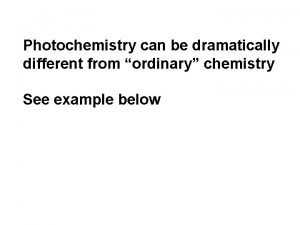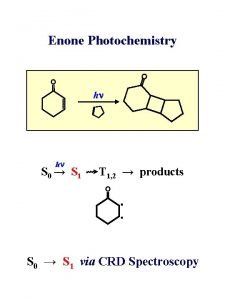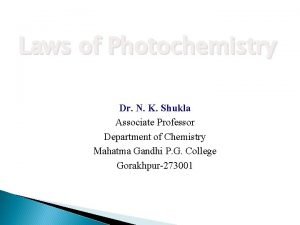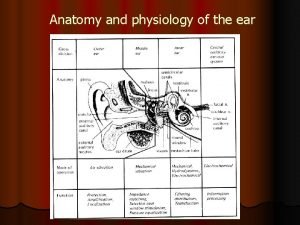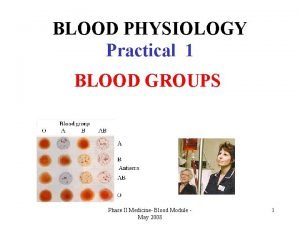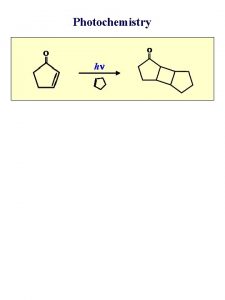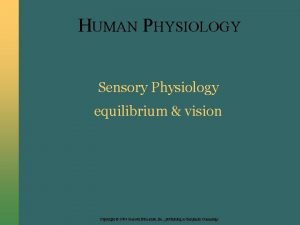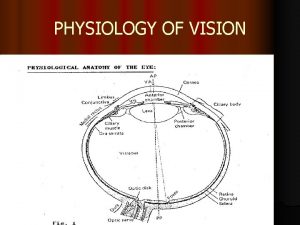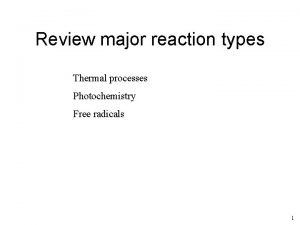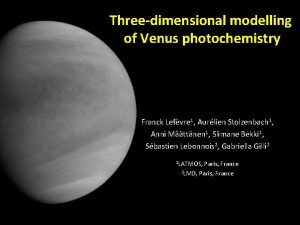Physiology of Vision Photochemistry of Vision Dr Sumera





































- Slides: 37

Physiology of Vision Photochemistry of Vision Dr. Sumera Gul

Learning Objectives • At the end of the lecture the students should be able to: • Discuss Light and Dark adaptation • Explain the mechanism of signal transmission in retinal neurons • Discuss the neurotransmitters released by retinal neurons • Explain the functions of various cells in retinal layers

Review of Previous Lecture


Rhodopsin-Retinal Visual Cycle • After exposure to light • Retinal (retinene) and Scotopsin separate




Color Vision • Blue sensitive pigment • Red sensitive pigment • Green sensitive pigment • Only one pigment is present in a cone

Color Blindness • Protanope • Deuteranope • Red-green color blindness X-linked recessive • 8% of all women are carriers

Light and Dark Adaptation

Light Adaptation • What will happen if a person has been in bright light for hours?

Light Adaptation • Large portions of the photochemicals in both the rods and the cones will have been reduced to retinal and opsins. • Furthermore, much of the retinal of both the rods and the cones will have been converted into vitamin A. • Low concentrations of the photosensitive chemicals in the rods and cones • sensitivity of the eye to light is correspondingly reduced.


Dark Adaptation • What will happen if a person remains in darkness for a long time?


Dark Adaptation • The retinal and opsins in the rods and cones are converted back into the light-sensitive pigments. • Vitamin A is converted back into retinal to increase light-sensitive pigments.

Dark Adaptation • After remaining is bright light when a person is exposed to complete darkness • Sensitivity if retina is very low initially • After 1 min increases 10 fold

Dark Adaptation • Dark Adaptation Curve • Early portion is due to adaptation of cones (4 times rapid) • Rods are slowly adapting • More sensitive • 100 or more rods converge on a single ganglion

Light Dark Adaptation • Change in pupillary size • Neural Adaptation

Neural Functions of Retina


Neurotransmitters of Retina • Glutamate is released from Rods and Cones at their synapse with bipolar cells • Amacrine cells release at least 8 neurotransmitters including • GABA, glycine, Ach, Dopamine, Indolamine

Horizontal Cells • Horizontal cells are inhibitory • Responsible for lateral inhibition • It enhances the visual contrast and allows high visual accuracy


Bipolar Cells • Can be depolarizing or hyperpolarizing cells • Can be due to different types of cells altogether • Or due to direct stimulation by Rods/Cones or via horizontal cells


Amacrine Cells • 30 different types Rods vision Onset and offset of visual signals Light turned on or off Respond to movement of spot

Ganglion Cells • 1. 6 million ganglion cells in each retina • 100 million rods • 3 million cones

Ganglion Cells • Peripheral retina is more sensitive to light • As there are more rods there which are 30 -300 times more sensitive to light. • And around 200 rods converge on a single optic nerve fibre.

W type Ganglion Cells Transmit signals at lower velocity mostly from rods Sensitive to detect directional movement in peripheral retina Important for vision in dark

X type Ganglion Cells • Small fields • Dendrites do not spread widely • Final and discrete visual image • Probably responsible for color vision

Y type Ganglion Cells • Largest of all cells • Fast • Broad dendritic fields • Respond rapidly to changes in visual image • Less discrete

P and M cells • Magnocellular cells • Parvocellular cells

Magnocellular Cells • Alpha cells • Not generally sensitive to color • Parasol cells • More sensitive to contrast black and white • To the magnocellular layer of lateral geniculate body • Sensitive to rapid movements • Larger receptive field • Faster

Parvocellular cells • Beta cells • Sustained response to color • Midget ganglion cells • Fine details • Parvocellular layer of LGN • Small receptive field • Slower

Questions?
 Photochemistry of vision
Photochemistry of vision Sumera iqbal
Sumera iqbal Cosmologia sumera
Cosmologia sumera H - c = c - h
H - c = c - h Photochemistry
Photochemistry Laws of photochemistry
Laws of photochemistry Grothus draper law ppt
Grothus draper law ppt Physiology of vision
Physiology of vision Physiology of vision
Physiology of vision Retinine
Retinine Cs766
Cs766 Pediatric exercise physiology
Pediatric exercise physiology Fish anatomy and physiology
Fish anatomy and physiology Anatomy and physiology
Anatomy and physiology Anatomy and physiology of meningitis ppt
Anatomy and physiology of meningitis ppt Anatomy and physiology edition 9
Anatomy and physiology edition 9 Difference between anatomy and physiology
Difference between anatomy and physiology Chapter 6 general anatomy and physiology
Chapter 6 general anatomy and physiology Anatomy and physiology
Anatomy and physiology Physiology of external ear
Physiology of external ear Aphasia means
Aphasia means Anatomy and physiology
Anatomy and physiology Waistline
Waistline Physiology of respiration
Physiology of respiration Types of physiology
Types of physiology Clinical significance of blood grouping
Clinical significance of blood grouping Mucous connective tissue
Mucous connective tissue Anatomy and physiology chapter 15
Anatomy and physiology chapter 15 Chapter 10 blood anatomy and physiology
Chapter 10 blood anatomy and physiology Cretinism
Cretinism Memory physiology
Memory physiology Art labeling activity: figure 14.1 (3 of 3)
Art labeling activity: figure 14.1 (3 of 3) Primary secondary and tertiary bronchi
Primary secondary and tertiary bronchi Aohs foundations of anatomy and physiology 1
Aohs foundations of anatomy and physiology 1 Uterus perimetrium
Uterus perimetrium Plant celldiagram
Plant celldiagram Wolters kluwer
Wolters kluwer Physiology of body temperature
Physiology of body temperature



